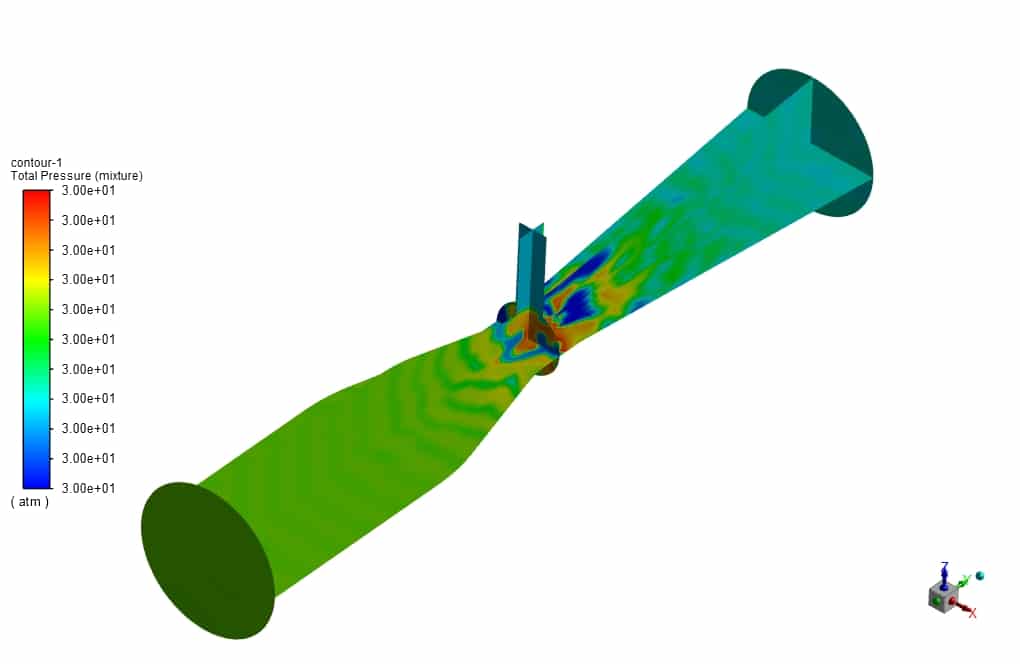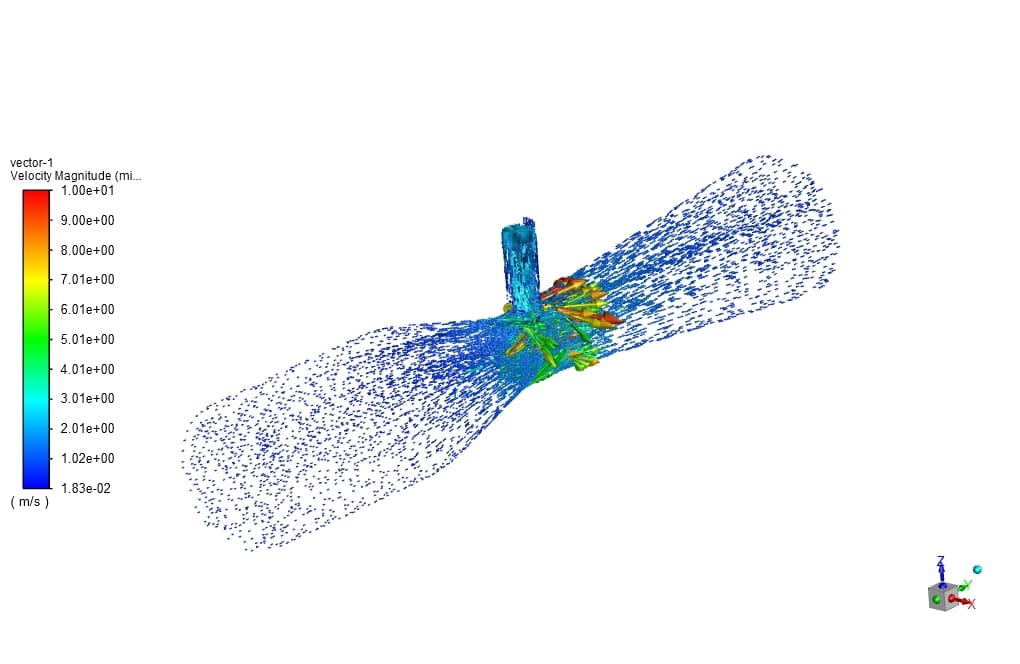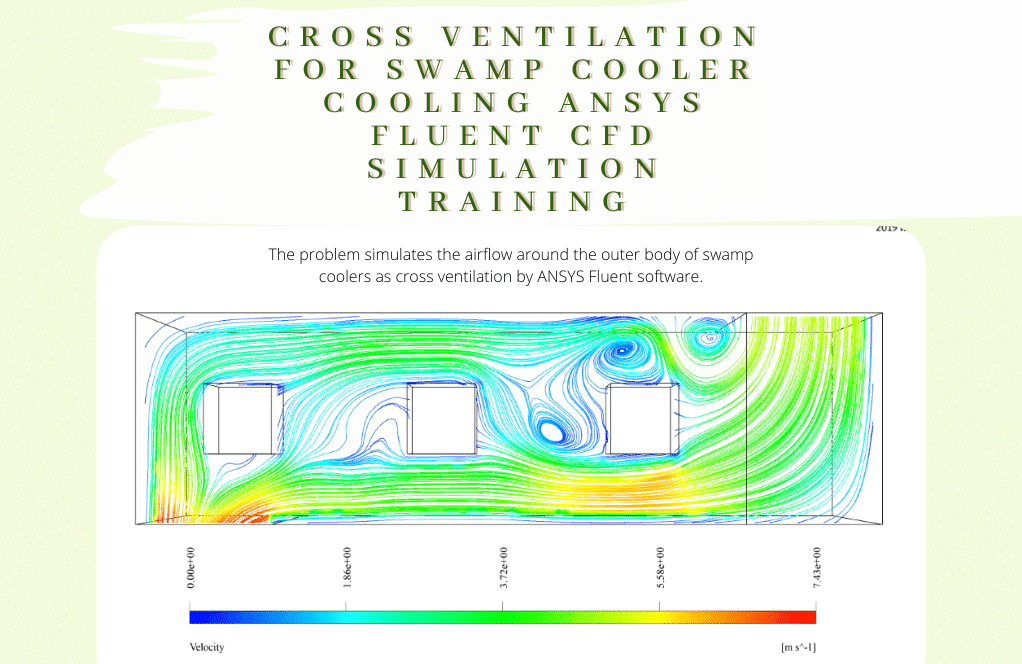Venturi Flow in a Tube for Air Suction, VOF Multi-Phase, ANSYS Fluent Training
$80.00 $40.00 Student Discount
- The problem numerically simulates the Venturi Flow in a Tube for Air Suction using ANSYS Fluent software.
- We design the 3-D model with the Design Modeler software.
- We mesh the model with ICEM software.
- The mesh type is Structured, and the element number equals 193932.
- The simulation is dependent on time so is performed in a transient form.
- We use the VOF Multiphase model to define a two-phase flow.
To Order Your Project or benefit from a CFD consultation, contact our experts via email (info@mr-cfd.com), online support tab, or WhatsApp at +44 7443 197273.
There are some Free Products to check our service quality.
If you want the training video in another language instead of English, ask it via info@mr-cfd.com after you buy the product.
Description
Description
In the present problem, a two-phase CFD simulation of airflow inside a Venturi and accurate modeling of air bubbles as a separate phase in water by ANSYS Fluent software is carried out. The venturi effect reduces the pressure in the fluid when the fluid passes through the narrow part of the pipe.
As the pipe diameter decreases according to the continuity equation, the velocity increases, and the pressure decreases due to energy conservation. Kinetic energy is balanced by pressure drop or pressure gradient. The present model is designed in three dimensions using SOLIDWORKS and then imported into the Design Modeler.
The meshing of the present project has been done using ICEM software. The elements are first used as hexahedral with fewer cells and better quality. The element number equals 193932, and the mesh type is structured. Moreover, due to the nature of the present problem, the transient solver has been enabled.
Venturi Methodology
In the present problem, a two-phase CFD simulation of airflow inside a Venturi using the VOF multiphase model and accurate modeling of air bubbles as a separate phase in water is carried out. The circulated mixed air stream enters the venturi with a volume fraction of 0.7.
After passing this stream through the bottleneck, the flow rate increases, and its pressure decreases. This pressure drop causes air to be sucked out of the hole located in the venturi throat. As air is added to the stream, the air volume fraction increases.
All inputs and outputs of this issue were at a pressure of 30 bar. This study evaluates the amount of air sucked by the venturi and its injection into water.
The VOF model is the best and simplest model suitable for determining the interface boundary between phases of multiphase flow. It is a Tracking Volume model based on the older MAC: cell and Marker model, a tracking-surface model.
In the VOF model, a set of momentum equations is solved jointly for all phases, and for each phase, a volume fraction equation of the continuity equation is solved. Using the Set Level model with VOF in the (VOF + Set Level Couple) section, it is possible to simulate the boundary between phases as accurately as possible.
VOF is designed and developed to track and determine the boundary between phases. We can say that this model is specifically used to simulate immiscible multiphase flow with collisions with definite boundaries between phases.
The Venturi tube has two different inlets. The mixture of air and water, containing 70% (volume fraction 0.7) water, enters through the main inlet boundary. Due to the pressure changes at the bottleneck, air can enter through the top boundary due to the pressure inlet boundary condition type.
Venturi Conclusion
At the end of the solution process, two-dimensional contours related to the velocity, pressure, air and water volume fraction, streamlines, etc., inside the domain are obtained.
As seen in the water volume fraction contour, the velocity of the incoming water flow causes air to be sucked into the venturi, and the sucked air is combined with water, creating a two-phase (air-water) fluid. Air bubbles can be seen in the water fluid.
Also, based on the calculated data from the Fluent software, the graph that represents the sucked air magnitude through the air inlet in terms of time is as follows,
When water passes through a bottleneck in a venturi tube, a vacuum is created at the end of the bottleneck. The hole in the pipe at the point where the vacuum occurs causes air to be sucked into the mainstream, leading to a turbulent flow.














Miss Angeline Brakus Sr. –
I’m truly impressed with how well-paced and informative the instruction was on simulating the Venturi effect in a tube for air suction using ANSYS Fluent. The VOF mult-phase modeling was exceptionally well-demonstrated, making the theory behind the phenomenon easy to grasp. The visuals provided during the training have given me new insights into multi-phase flow simulations and will certainly enhance my future projects.
MR CFD Support –
Thank you for your positive feedback! We’re thrilled to hear that our Venturi flow simulation training using ANSYS Fluent has contributed to your understanding of multi-phase flow and the Venturi effect. It’s great to know that our instructional materials and visuals were helpful to you. We look forward to continuing to support your future projects with our resources. If there’s any other way we can assist, please let us know.
Meaghan Halvorson II –
I was fascinated by how the simulation handled the air suction through the Venturi throat and how air volume fraction increased as it passes the constriction. Could you explain how the mixture of two phases was tracked accurately within this system?
MR CFD Support –
In this simulation, the tracking of the mixture of two phases – water and air – within the Venturi tube utilizes the Volume of Fluid (VOF) model. The VOF model is particularly effective for resolving immiscible fluids with distinct interfaces. A set of momentum equations is solved concurrently for all phases, and the VOF method solves a volume fraction equation for each phase as part of the continuity equation. Additionally, utilizing the Level Set method enhances the accuracy in tracking the interface boundary between the phases.
Viviane Gottlieb –
The course sounds detailed. Can you tell me, do we get to see the animations of multiphase flow during the training?
MR CFD Support –
Yes, as part of the training, you will have access to visual animations that demonstrate the multiphase airflow within the Venturi tube. These animations help enhance understanding of the flow dynamics, such as how air is sucked in and mixes with water, and the formation and movement of air bubbles.
Prof. Saige Quigley II –
The training material is outstanding! It was fascinating to see the VOF multiphase model in action, and how it accurately captures the air-water interaction. The step-by-step guide was extremely helpful for understanding the setup and the results. Seeing the Venturi effect in such detail, especially the air suction induced pressure drop, has cleared up many concepts for me. Fantastic job on providing such a comprehensive and hands-on learning experience!
MR CFD Support –
Thank you so much for your positive feedback! We’re thrilled to hear that our training material on the Venturi Flow simulation using VOF multiphase model in ANSYS Fluent has helped clarify the concepts for you and proved to be valuable. If you have any further questions or need additional assistance, please don’t hesitate to reach out.
Isaias Klocko –
I was fascinated by how efficiently the venturi effect is simulated in this project. The detail provided on airflow modeling and the tracking of air bubbles is quite impressive, and I can tell this will be a valuable resource for my studies on multiphase flow!
MR CFD Support –
We’re thrilled to hear that you found the simulation details on the venturi effect and the air bubbles tracking to be impressive and resourceful. Your enthusiasm for our training materials is much appreciated, and we’re glad they will assist your studies on multiphase flow. Thank you for your kind words!
Ms. Ashlee Champlin –
This Venturi tube simulation course looks very interesting! But just to clarify, does it include both theoretical concepts as well as practical exercises in ANSYS Fluent?
MR CFD Support –
Absolutely! The Venturi tube simulation training covers both the theoretical aspects of fluid dynamics involved in a two-phase flow through a Venturi as well as practical, step-by-step exercises using ANSYS Fluent to ensure the concepts are well understood and applied effectively.
Nicola Bergstrom I –
The simulation sounds interesting. Can you explain if it is possible to observe the cavitation effect in this Venturi tube simulation using ANSYS Fluent?
MR CFD Support –
In this specific Venturi tube simulation, the focus is on the two-phase CFD simulation of airflow and venturi effect with air suction and water injection. While the simulator ANSYS Fluent is fully capable of simulating cavitation effects, there is no direct mention of cavitation modeling in the provided description as it primarily addresses air-water interaction via VOF. To capture the cavitation effect, additional setup in terms of modeling choices and boundary conditions would be required, including enabling and adjusting specific cavitation models those Fluent provides.
Prof. Thad Sporer –
After completing the CFD training on the Venturi flow simulation, I’m pleasantly surprised with the level of detail in the methodology and the clarity of the results explained. It is evident how the water and air interact and how the pressure variations facilitate the suction of air. The visuals provided, such as the velocity and volume fraction contours, were particularly helpful in comprehending the complex dynamics at play.
MR CFD Support –
Thank you for taking the time to share your review. It’s wonderful to hear that you found the CFD training comprehensive and the explanatory visuals helpful. We strive to provide clear, detailed methodologies and results that aid understanding of complex fluid dynamics. Your positive feedback motivates us to continue delivering high-quality educational content.
Miss Candice Mertz DVM –
What was the specific reason for choosing the VOF model in this simulation, and could other multiphase models be used for this analysis?
MR CFD Support –
The VOF (Volume of Fluid) model was chosen for this simulation because it’s well-suited for tracking and determining the boundary between immiscible fluids with a clear interface, such as air and water. The VOF model is capable of accurately capturing the free surface and phase distribution, making it an ideal choice for evaluating the air suction phenomena in a Venturi flow with air-water interaction. While other multiphase models like the Eulerian or the mixture model could theoretically be used, the VOF model is typically preferred for its accuracy in cases where you have a distinct interface between the phases, as in the simulation of Venturi effect with air bubble formation.
Prof. Nicolas Mueller II –
I’ve been tackling multiphase flows in my studies, and this training has caught my interest. However, before purchasing, may I know if during the training, slicing of the domain for better visualization and post-processing analysis of specific sections of the fluid flow is discussed and demonstrated?
MR CFD Support –
Yes, the training offers extensive learning on various aspects of dealing with multiphase flows, including techniques like slicing the domain for better visualization. This method is used to analyze specific sections of the fluid flow, helping you understand the changes in flow patterns, phase distribution, and pressure variations throughout the Venturi tube.
Roberta Mueller –
I am thoroughly impressed by the level of detail in the contour results. It truly showcases the complex interaction between the air and water phases. Can you advise if this two-phase CFD simulation project also includes tutorial videos or step-by-step instructions to assist beginners in learning how to set up and run such simulations?
MR CFD Support –
Thank you for your kind words! We are glad to hear that you find the detailed contour results impressive. Regarding your query, our training package indeed includes comprehensive tutorial videos and step-by-step instructions to aid learners in mastering the setup and execution of two-phase CFD simulations using the VOF model in ANSYS Fluent, ensuring beginners have the guidance they need.
Prof. Sarina Hauck I –
I’m impressed by the detailed explanation of the physics involved in the Venturi tube scenario. Could someone clarify if there are any special considerations one must take when setting the initial conditions for the air-water mixture to achieve accurate results?
MR CFD Support –
Absolutely! When setting the initial conditions for a two-phase flow in a Venturi system, one must specify the initial volume fraction of each phase in the mixture. In this case, the water had to initially have a volume fraction of 0.7, as specified. Moreover, the correct velocity and pressure settings are crucial, particularly at the two different inlets, to accurately depict the vacuum and resultant air suction. The initial placement of the phases could also affect the way in which the air bubbles get entrained into the water during the simulation, so this aspect should also be carefully defined.
Susana Romaguera –
I am really interested in the details of how the VOF model is utilized for air bubble tracking. Could you explain a bit more about this process?
MR CFD Support –
In this simulation, the Volume of Fluid (VOF) model is used to accurately track the phase interface between air and water. The model solves a set of momentum equations for the mixture while solving a continuity volume fraction equation separately for each phase to determine the distribution and evolution of the air bubbles in water as they move through the Venturi tube. As air enters the system due to pressure reduction at the bottleneck, the VOF model captures the transition of these air bubbles within the water, predicting their behavior and interactions accurately throughout the process.
Abdiel Doyle –
Just finished the Venturi Flow in a Tube training module. The way air bubbles were accurately simulated and tracked using the VOF model was fantastic! Seeing how the changes in velocity and pressure allowed for air suction at the hole located in the throat of the venturi and their impact on the two-phase flow provided such clear and rich insight – Principles of fluid mechanics beautifully illustrated. Kudos to MR CFD for such an engaging and informative simulation experience.
MR CFD Support –
Thank you for your wonderful review of our Venturi Flow in a Tube training module! We’re thrilled to hear that our simulation provided clear insights and helped illustrate the concepts of fluid mechanics. Your feedback is greatly appreciated, and we’re delighted that you found the training engaging and informative.
Elliot Swift –
This review truly captures the essence of the CFD simulation results for the Venturi Flow as well as the thoroughness of the ANSYS Fluent course material! Your detail on the volume fraction and the way in which the pressure changes were captured is appreciated. Thank you for acknowledging the precision of the model in simulating multiphase flow and defining phase boundaries. Your understanding of the physics involved in a venturi, illustrated by the described outcome, reflects the efficacy of the training. Keep up your exploration in fluid dynamics!
MR CFD Support –
We are overjoyed to receive such positive feedback on our ‘Venturi Flow in a Tube for Air Suction, VOF Multi-Phase’ ANSYS Fluent training module. It’s wonderful to hear that our course material has helped enlighten you on the complexities of CFD simulations. Thank you for taking the time to highlight the key aspects of the Venturi effect and how our simulation captures these intricate details. Your engagement and excitement motivate us to continue delivering high-quality educational experiences. Keep delving into the world of computational fluid dynamics, and don’t hesitate to reach out to us for more insightful courses!
Dr. Alana Mraz –
I just completed the Venturi Flow in a Tube for Air Suction course, and I was impressed by how the VOF Multi-Phase model was explained. The intricate details, especially regarding the capture of the interface between water and air, were incredibly enlightening.
MR CFD Support –
Thank you for your positive feedback! We’re delighted to hear that the course on Venturi Flow with the VOF Multi-Phase model met your expectations and provided you with a clear understanding of phase interactions. If you have any more questions or need further clarification, feel free to reach out.
Vena Weimann –
Is the pressure change observed in the simulation corresponding well to the theoretical predictions of the Venturi effect, particularly at the narrowest section of the tube?
MR CFD Support –
In our CFD simulation, the pressure changes indeed correspond well to the theoretical predictions of the Venturi effect. As water accelerates through the narrower section of the tube, we observe a decrease in pressure that aligns with the principles of conservation of energy and the continuity equation.
Matilda White –
The course content is comprehensive and articulately laid out. The balance between theories, practical application, and the use of ANSYS Fluent software for two-phase CFD simulation is of great value for aspiring engineers. This training not only reinforced my understanding of the Venturi effect but also gave me a practical perspective on simulating air-water interactions in flowing systems.
MR CFD Support –
Thank you for your positive review! We are thrilled to hear that you found our training on Venturi Flow in a Tube for Air Suction comprehensive and practical. It’s our pleasure to provide valuable content that enhances the learning experience for engineers and helps them apply theoretical knowledge in practical situations. If you have any more insights or questions, feel free to reach out to us anytime!